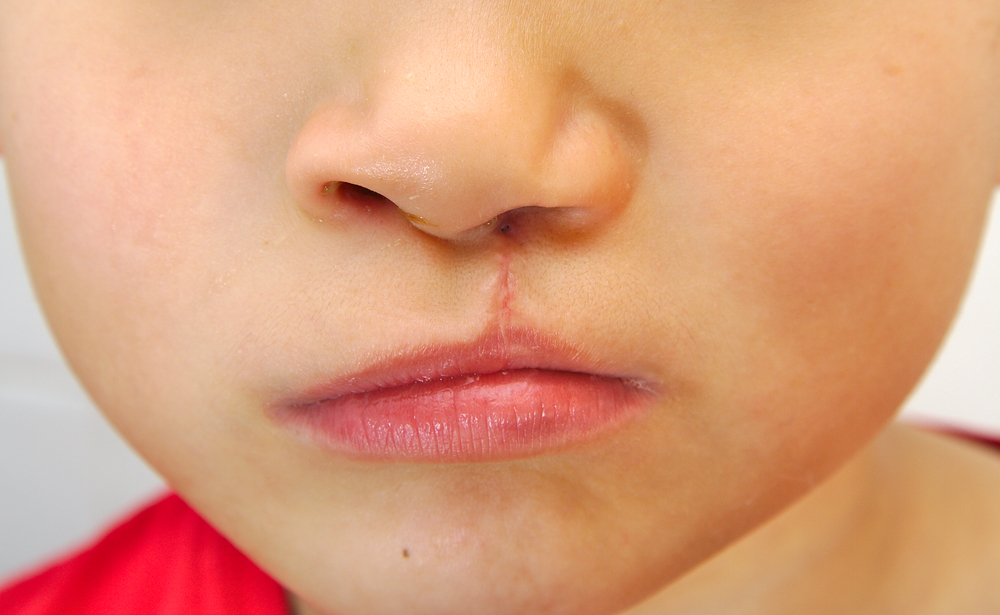- Nearly all cases of cleft lip and cleft palate are diagnosed before birth (via ultrasound), or at birth because the defect is clearly recognizable.
- Cleft lip surgery is performed between 3 and 6 months of age, while cleft palate surgery is done preferably between 12 and 15 months
- Children who have a cleft lip, with or without cleft palate, may have ongoing feeding and speech problems, along with frequent ear infections and a higher risk of hearing and dental problems.
What is cleft lip and cleft palate?
Cleft lip and cleft palate — also known as orofacial clefts — are the result of birth defects where the mouth and lip structures have failed to form properly during the first trimester of pregnancy.
According to the Center for Disease Control and Prevention, 2,650 American babies are born with cleft palate each year, and 4,440 are born with cleft lip, which amounts to approximately one in every 500 children.
What are the symptoms of cleft lip and cleft palate?
Nearly all cases are diagnosed before birth (via ultrasound), or at birth because the defect is clearly recognizable.
There are rare cases when a baby could have a cleft palate involving his/her soft palate in the back of his/her throat. This is usually tough to diagnose during an initial exam. If your baby has difficulty latching onto a breast or baby bottle during feeding, this can be a sign of a problem and should be reported to your physician.
What causes cleft lip and cleft palate?
The cause of this common condition are largely unknown, but it is thought to be a combination of genes and other factors that influence development. These factors include environmental chemicals, food, alcohol exposure, medications, folic acid deficiency, and infections.
Known risk factors also include smoking during pregnancy, obesity, diabetes, epilepsy, and medications (topiramate, phenytoin and valproic acid) taken during the first trimester. A diagnosis for orofacial clefts can take place during pregnancy via ultrasound, or once the baby is born.
To treat cleft lip or cleft palate, plastic surgeons undergo specialized training in children’s craniofacial surgery. To learn more this procedure we spoke with North Texas plastic surgeon Dr. Sacha Obaid, and New Jersey plastic and reconstructive surgeon Dr. Francesco Gargano.
Common types of orofacial defects
A baby can be born with an orofacial cleft when tissue in the developing mouth and the palate don’t fuse together properly. In such cases, there are three overarching groups of defects that can occur:
- Cleft lip alone
- Cleft palate alone
- Cleft lip and cleft palate combined
Cleft lip and cleft palate combined are twice as common than either on its own. A cleft lip deformity is when there is an opening or gap in the upper lip. The gap can be unilateral (one side) or bilateral (both sides). For instance, if it’s a unilateral cleft lip, the gap would extend from the lip under one side of the nose (left or right), and may extend into the nostril.
The palate is the roof of the mouth. With cleft palate there is an opening between the roof of the mouth and the nose. This can be part way through the palate, or in some cases it may be the entire palate that has failed to fuse properly.
The image below demonstrates these different types of defects.

A) Normal development
B) Cleft palate alone
C) Unilateral cleft lip and alveolus
D) Bilateral cleft lip and alveolus
E) Unilateral cleft lip and palate
F) Bilateral cleft lip and palate.
In either case, these orofacial defects can be corrected through reconstructive surgery.
At what age is cleft surgery performed?
“Cleft lip surgery is performed between 3 and 6 months of age, while cleft palate surgery is done preferably between 12 and 15 months,” says Dr. Gargano.
“The timing of the palate surgery is particularly important for speech development. The goal of the cleft palate surgery is normal speech development and feeding ability for the child.”
Cleft palate and cleft lip surgery procedures
The goal of surgical procedures is to address the many aspects affected by the deformity — appearance, speech, breathing, feeding, and hearing.
Cleft lip surgery
“Cleft lip surgery is performed between 3 and 6 months of age and involves closure of the lip defect and the alveolar defect. At the time of cleft lip repair a primary rhinoplasty of the tip of the nose is required through minimal incisions. The surgery will allow the patient to have a better feeding and also to guide the growth of the maxilla (jawbone). Repositioning of the upper lip and nose is also achieved with this surgery,” informs Dr. Gargano.
Cleft palate surgery
“Palate surgery is done preferably between 12 and 15 months of age. As already suggested, the timing of the palate surgery is very important for speech development. The palate surgery involves closure of the nasal and palatal mucosa and repositioning of the levator muscle in its proper anatomical position,” says Dr. Gargano.
Both surgeries are performed under general anesthesia.
What is the recovery?
“Parents should expect to keep their baby at the hospital overnight after cleft lip surgery,” says Dr. Obaid. “Most babies will be able to feed during the night, and they can go home the day after the procedure. Only one night in the hospital is generally necessary after cleft palate surgery as well, but feeding restrictions (eg: liquids only for the first 24 hours, drinking from a cup or other vessel as opposed to nursing or bottle feeding) will apply for a week or more.”
Dr. Gargano elaborates saying, “sutures will be removed one week after cleft lip surgery, with two weeks of recovery time. As for cleft palate repair, a three week recovery time is to be expected.”
In general, the wounds are completely healed in around 6 weeks. And in terms of scars, cleft lip surgery will leave a small scar between the upper lip and the nose.
What are the potential complications?
“General complications related to any surgeries are wound dehiscence (wound rupture along the incision), infections, swelling, bleeding, and airways obstruction,” advises Dr. Gargano. “Specific complications related to cleft lip and palate repair include asymmetry, need for revisions, velopharyngeal dysfunction, along with oronasal and alveolar nasal fistulas.”
Velopharyngeal dysfunction occurs in approximately 30 percent of patients, when parts of the throat or the roof of the mouth do not function correctly during speech. Essentially, the palate fails to rise to touch the back of the throat as it does in normal speech, causing air to escape through the nose. This inhibits speech, making the child difficult to understand in many cases.
When this dysfunction occurs, patients will require either non-surgical interventions such as speech therapy or prosthetic devices. Secondary surgery to re-repair and reposition the soft palate may also be required.
What is the cost of cleft surgery?
If you do not have health insurance, you should expect to pay around $8,000 for either cleft lip or cleft palate surgery. If your child requires both cleft lip and cleft palate surgery the cost is typically around $12,000.
Aftercare and the future
Children who have a cleft lip, with or without cleft palate, may have ongoing feeding and speech problems, along with frequent ear infections and a higher risk of hearing and dental problems.
Therefore, over the course of their lifetime it is not uncommon for a child to consult with a group of health professionals including medical, surgical, dental, and allied health disciplines.
“Although improvement of speech and feeding is expected immediately after the surgery, the addition of speech therapy will help the child with speech development and acquired sounds,” says Dr. Gargano.
Some children who have had their cleft palate repaired will not achieve complete closure for 3-4 months following surgery. However, research suggests that by the ages of 14 to 18 months, speech differences in achieving stops and vowels between typically developing children and those who have had cleft palate repair and infrequent.
Parents should also expect that their children may require additional surgeries at a later stage. Dr. Gargano advises that rhinoplasty (a nose repair or reconstruction) may be necessary in some cases. It is also likely that children will undergo orthodontic treatment. On top of this, when the growth of the maxilla is complete, they will be evaluated for orthognathic surgery, which can correct any conditions of the jaw and face that can’t be treated with braces.
“Patients with a cleft lip may require an additional surgery called a LeFort I osteotomy,” informs Dr. Obaid. “This is performed to align the bite and correct abnormal facial development, generally around the age of 5, before the child starts school. In the event that a child who has undergone cleft palate surgery is still struggling with speech issues, a secondary surgery called a pharyngeal flap can revise the airway and help the voice and speech. This procedure is performed at around 4 to 6 years of age.”
“The good news is that most babies with a cleft lip or palate are otherwise in perfect health,” says Dr. Obaid. And despite some possible setbacks, most children with this condition live normal happy lives after surgery.









